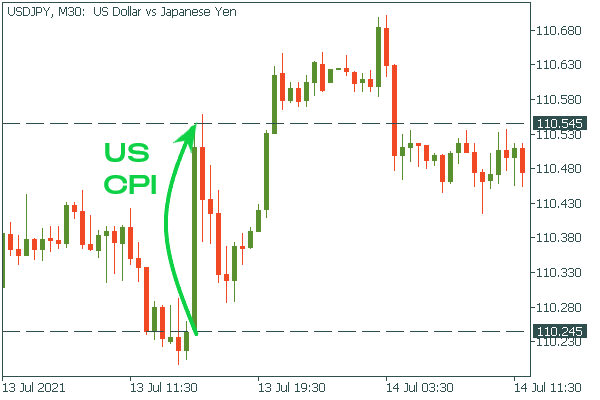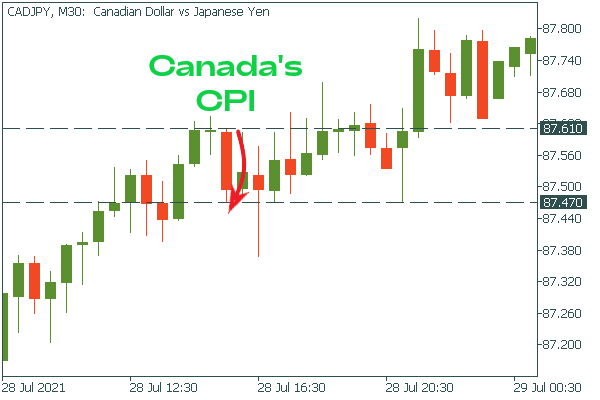What Is Consumer Price Index?
What does CPI stand for?
Consumer Price Index reveals the weighted average change in prices that consumers pay for a basket of goods and services, such as food, energy, housing, clothing, transportation, medical care, entertainment, and education. Changes in the CPI are used to measure price changes tied to the cost of living. An accurate gauge of changes in the cost of living is essential for different people and organizations such as central banks.
What is a basket of goods?
A basket of goods is a fixed group of consumer products and services the price of which is assessed regularly: often on a monthly or annual basis. The aim of creating this basket is to track inflation in a certain market or country. If the price of the basket of goods grows by 2% in a year, inflation can be said to equal 2% as well. The basket of goods is a sample that should represent the overall economy, that’s why some goods are replaced by others periodically to comply with consumer habits.
*The basket of goods consists of basic food and beverages such as milk and coffee. It also covers housing costs, furniture, transportation fees, health care costs, toys, and even tickets to museums. Education and communication costs are listed in the basket as well as other random products such as tobacco, haircuts, and funerals.
Where to find CPI data?
Consumer prices account for a majority of overall inflation, that’s why you can notice the term Inflation Rate instead of CPI in our economic calendar. Don’t be confused – they both show the same data.
There are two versions of the reports: Inflation Rate and Core Inflation Rate. The difference between them is simple: the core indicator excludes food and energy prices due to their volatility.

Besides, there are other indicators of inflation such as Producer Price Index (PPI), Wholesale Price Index (WPI), Retail Price Index (RPI). Still, CPI tends to be more impactful in terms of Forex trading.
How Is CPI Used?
As we said, the Consumer Price Index is the most common gauge of inflation. It shows to the government, businesses, and citizens how prices have changed in the economy over some period. Based on CPI, retailers predict future price increases, employers calculate salaries and the government defines cost-of-living increases.
When inflation rises, the purchasing power declines, which means that a consumer can buy fewer goods and services for every currency unit (let’s say, 1 dollar). Otherwise, when inflation falls, the purchasing power increases, which means that a consumer can buy more goods and services for every currency unit.
The most interesting thing for traders is that the central banks make policy decisions based on the Consumer Price Index data. Thus, not only the actual CPI data but even traders’ expectations for the CPI release increase volatility in the Forex market.
- Rising prices can lead the central banks to increase interest rates, which will result in the appreciation (increase in value) of the national currency.
- Alternatively, when inflation becomes too low, the central bank is likely to reduce interest rates, which will inevitably lead to the depreciation (decrease in value) of the domestic currency.
How does CPI impact Forex trading?
The release of the Consumer Price Index tends to cause massive movements in the Forex market. Pay attention that it refers only to the countries which currencies are liquid.
Based on liquidity, there are three currency categories in the global Forex trade: majors, minor currency pairs, and exotic currencies. Major currencies are the most popular and liquid. The major currencies include the US dollar, the British pound, the euro, the Japanese yen, the Australian dollar, and the Canadian dollar. Thus, pay closer attention to the CPI releases of the US, UK, Canada, EU, Japan, Australia, and New Zealand.
How to trade on CPI?
Traders compare the forecast with the actual CPI data, which you can check in the economic calendar.
- If the actual CPI data is greater than expectations, the currency will rise.
- If the actual CPI data is lower than forecasted, the currency will drop.
It’s a good idea to check the time of the next CPI release before, open the charts with the currency of the country issuing CPI to be fully prepared once it’s out, and monitor the price movement.
What about stocks markets? Are they affected by CPI? Stock markets generally aren’t driven as much by CPI numbers, but sometimes they can be! Higher inflation and consequently higher interest rates can force economic activity to slow. Therefore, as a rule, stock markets favor a lower CPI that lets consumers keep spending, and businesses continue investing even more.
Examples
For instance, the Bureau of Labor Statistics revealed the US Consumer Price Index (Inflation Rate) on July 13. The CPI came out greater than expected. Look at the screenshot of the economic calendar below.

As a result, USD/JPY rocketed by 300 points in half an hour after the release! In the chart below, you can observe that huge movement.

Let’s discuss the example when Consumer Price Index fell short of analysts’ expectations. On July 28, Canada’s CPI (Inflation Rate) came out lower than anticipated: 0.3% vs the market estimate of 0.4%.

After the release, CAD/JPY has plunged by 140 points. Such a rapid fall only in 30 minutes! Indeed, economic indicators such as CPI tend to cause huge swings in the charts. Therefore, traders should follow economic releases and monitor the price movement during these events.

What is happening with inflation now?
The CPI can sometimes be affected by an increase in the price of a certain commodity. For example, a hike in oil prices can impact transportation, food, utilities, and retail sales. The huge increase in the price of one commodity can cause a domino effect, which can make investors and traders change their strategies in the Forex market.
This is so similar to the current situation. Oil and gas prices have been sharply rising in September 2021. These commodities are used in essential activities such as fueling transportation and heating homes, which became even more important before the winter season. Rising commodity prices increase the costs of all these activities and thus push inflation up.
Speaking about the US dollar (the most traded currency in the Forex market), the higher US inflation should push the Federal Reserve to taper stimulus from November and hint at the rate hike earlier than initially thought. Investors expect this to happen and thus invest their capital in the USD. As a result, the USD hit a one-year high!
Other central banks experience high inflation as well these days. However, banks don’t rush to fight it. The Covid-19 crisis makes it harder for central banks to hike rates or reduce bond buys as the economic health of their countries is not good enough. Sooner or later, all of them will start increasing rates, which will push the currencies of these countries up. Therefore, the current CPI reports grab so much attention these days!
Follow our news to never miss important economic reports!
If you are interested in fundamental analysis, we highly recommend you to read the following articles: